Any time a new game by Vital Lacerda is about to hit, my assorted tabletop gaming networks come alive.
There’s always a big negotiation on the front end. Who’s going to sink $150-$200 for the newest crowdfunding campaign? Are the hardcore collectors going to jump in or wait for someone else to pull the trigger before buying their own copy? As Eagle-Gryphon Games—the publisher of Lacerda’s games in the US—begins to send out shipping notifications, the hype machine ramps up.
Inventions: Evolution of Ideas is the newest Lacerda release, arriving at homes around the world right now. When I got a shipping notification for my review copy, I alerted a couple groups that I’d have my copy in time for game nights the following week.
“I’m innnnnnnnnn,” announced one friend, as creepily as that sequence of extra N’s would indicate.
“I can be at your house within the hour,” said another.
One friend toyed with an existing relationship. “I really want to play this one, but I have Valentine’s Day plans.” It sounded like he was open to bailing on the marriage to get a play in.
New Lacerda games bring out all the fans, and rightfully so. I’ve written six articles on the Portuguese designer’s heavy Euros, covering games such as Kanban EV (as well as the SpeedCharger expansion), The Gallerist, On Mars, Vinhos: Deluxe Edition and Weather Machine. I’ve also played most of his other games, including Escape Plan, Lisboa, and Mercado de Lisboa.
Spoiler alert: I’m a fan. When Inventions: Evolutions of Ideas showed up at the house, I went into attack mode. I read the rulebook a whopping six times before feeling prepared enough to teach the game to new players, as no teach video was available when my copy arrived. Then, I played Inventions four times over a five-day stretch (two separate three-player games, a two-player game, and a solo play). I wanted to really feel this one out before sharing my thoughts.
Here’s the executive summary: this is one of my three favorite Lacerda designs already. It helps that I really love creative, tactical game experiences.

Miles of Milestones
Inventions is a 1-4 player action selection strategy game that places players in charge of societies over the course of human history. Yes…ALL of human history.
Over the course of 13 main turns, players will place one of their three “Pillars of Time” on a large section of the board offering 10 different actions, an area known as the Assembly. None of an opposing player’s Pillars block any other Pillars, unlike every Lacerda game I’ve played. Inventions showcases ideas unique to the designer’s other classics in a very welcome way.
Save for a minor bonus given to players who have their largest Pillar (known as their Epoch token) in a space you visit, Spaces are mostly available. Now, there are a couple of limitations to this, particularly tied to the five rows of 10 actions. Each row is called a Forum. During each Era (three rounds), players can’t visit a Forum they have already visited that round, and their Epoch token has to move to a new location when taking an action.
I love this part of the design. I also love how easy it is to tell which actions you can and cannot take on your next turn. I never felt like I was limited to an action based on the placement of other players, but there is a small and eventually meaningful bonus to other players if they guessed that you might be interested in an action later in a round.
Save for Lisboa, most Lacerda games I’ve tried feature a single pawn placed at a single location to take a turn’s main action (see: The Gallerist, Kanban EV, Vinhos: Deluxe Edition). In some ways, it will be culture shock for a Lacerda veteran to discover that action spaces in Inventions are not blocked, but this is the kind of culture shock many players will appreciate.

That shock doesn’t stop with the way turns are orchestrated. In fact, one of the biggest shocks with Inventions is the lack of Executive Actions, the general term used in most Lacerda games for bonus actions that can be taken before or after a player’s main action. Inventions twists the concept every which way it can: turns begin by preparing “Chain Actions”, the name for bonus actions here. Each player will normally start a turn with at least one, and as many as three, bonus actions for use on every turn.
Then things get a little wacky. Most of the game’s core actions, such as presenting ideas to different regions, inventing those ideas, and sharing ideas to the world, don’t allow a player to take a bonus action. In other cases, particularly for most of the game’s six minor / non-core actions, players can usually follow the main action with a bonus action…but the bonus actions can be limited. Sometimes, players will take a minor action, chain into a main action, then chain again into another action.
That means that some turns—or maybe, “turns”—actually feature 2-3 full turns. In some cases, I’ve seen players present an idea in a region of the map that grants a bonus action of presenting another idea, which doesn’t use a chain action. In other cases, a player might use their main action to do the “Send Diplomat” action to move a meeple from their player mat to a Milestone tile in a player’s Private Display. That might allow them to take the Travel action. Doing that might let them take a bonus action at the location one of their meeples traveled to, which could lead to another chain action—
Whoa, whoa, whoa. We should pause here to talk about one of the negatives with the Inventions design: downtime.

I Love Combos, But…
On average, Inventions plays in about 45-55 minutes per player, at least in my initial four plays. Certainly that will come down a bit with more plays, like all games where players have a good feel for the rules.
But even at three players—essentially the minimum for Inventions, because both the solo and two-player variants require dummy players to be managed during play—you will find that you might have to wait about ten minutes to take your next main action.
Some of this is mitigated by the game’s third puzzle (beyond the main map of the world and the Assembly area with action selection tokens), the Progress Map. Each player’s mat features a large tile-laying area that will slowly build during the course of play. Many actions grant players a chance to select tiles that match the three meeple categories of the game: economy (meeples that are known as traders), culture (artisans), and technology (thinkers). These tiles grant ongoing powers, one-time-use boosts, and once-per-era bonuses.
Thankfully, after a player finishes their main and chain actions, the Inventions design was built so that players can play around with their Progress Map while the next player executes their main action. Players won’t engage with the Progress Map every turn, thanks to a somewhat overcomplicated system tied to tiles requiring meeples to be exhausted to place them on the Progress Map, as well as a one-time Influence cost, which we haven’t even covered yet.
While this puzzle is fun, it doesn’t occur each turn, and in some cases you’ll take a quick action during your turn, then watch as someone pulls off a combo series that takes a few minutes to finish. If the next player does the same thing, it can make for a long wait.
It is for these reasons that I think Inventions fits best as a three-player game with three human beings at the table. Four players, with even one of them taking overly deliberate turns, could turn Inventions into a four- or five-hour game. (One of my games was set to be a four-player game before a last-minute cancellation; I told this friend later that I was thankful he didn’t make it to the game night.)
There are better ways to spend that much time. For one, I’d rather play Inventions twice with three experienced players than once with four newer players in the same amount of time!

The Creativity
In a lot of ways, I love taking turns in Inventions just like I love taking turns during games of Tiletum, the medium-weight dice wheel Euro designed by Simone Luciani and Daniele Tascini a couple years ago. You need to have a long-term plan with Tiletum, but each turn is a tactical buffet of choices.
The thing I love about both Tiletum and Inventions: you can do almost any action, any time, somewhere on the board.
In Tiletum, let’s say I want to do the Architect action. You might try to select a die attached to the Architect action…but, maybe the dice there are gone. The Joker action might be available, so that could achieve the same goal. Let’s say the Joker dice are gone, too. You might have a bonus tile on your player board that has the Architect action, so that would do the trick. Or maybe you could just take the Merchant action to walk your buggy down the beige roads of Europe to find an Architect tile to take the Architect action that way.
There are a thousand ways to skin a cat in Tiletum, so if you have the will, there’s always a way. Inventions does this in ways that require a lot more creativity (Inventions is a much more dense rules load), but I think that makes the search more rewarding.
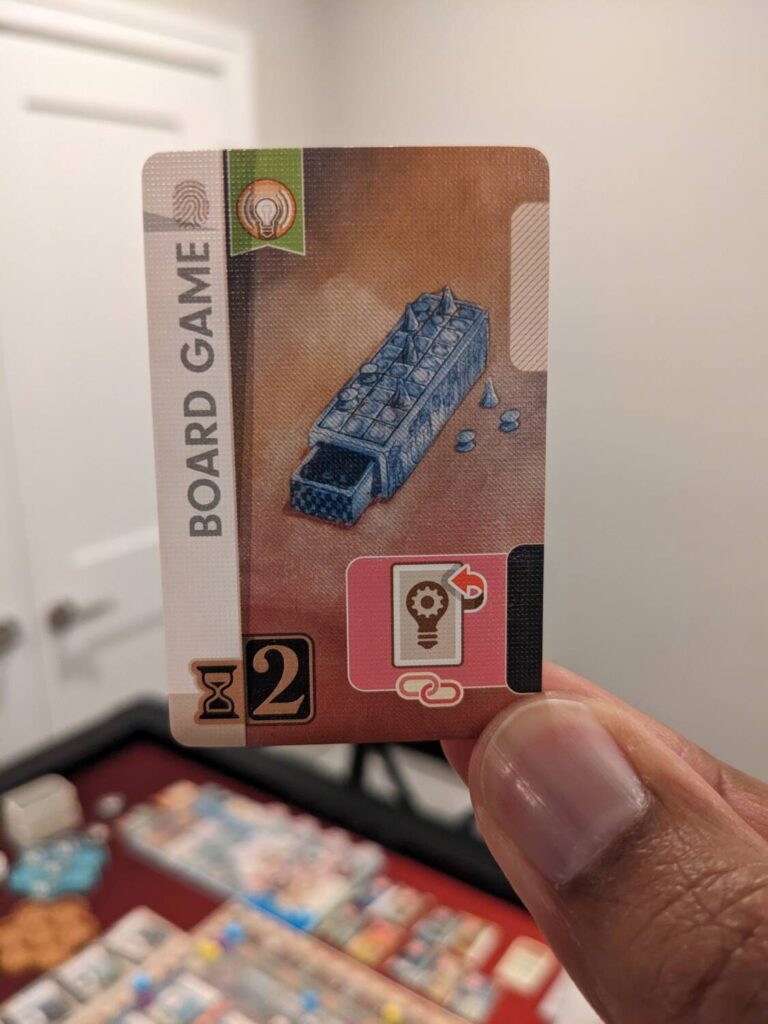
On a number of turns, players will find that their path to moving a Pillar of Time to their preferred action may be difficult. Maybe another player’s Epoch token is there and they really don’t want to give their neighbor a slight boost on the Influence track, which grants players more chain actions. Maybe the action they wanted was on the main map of the globe, but the tile featuring their preferred bonus action was flipped on a previous player’s Travel action.
But the action you really want is somewhere, every turn. Even the game’s rarest action (in terms of frequency needed during the game), the Eureka action, can be found on some of the Idea/Inventions cards that will be flipped and added to the area near a player’s personal mat during play. You just have to scan all the available sources to find what you need.
For a really creative person, willing to spend some time between turns (not on their main turn, when everyone is waiting…please!!!), Inventions is brilliant. Much like the light bulbs that adorn the cover—another cover star from Ian O’Toole—Inventions has a lot of these “a-ha!” moments that really make the game shine.
That extends to the actions. Finding your action somewhere in your play area or the main board is one thing. But then, finding ways to extend turns by using your chain action on almost every turn might be the best part of the game. Even the manual hints at the fact that your chain actions are “use it or lose it” every turn…why not find ways to take two turns on every turn? Or three? It’s a Euro, so efficiency is key, but efficiency really spikes if you can find a way to take 20 or 25 turns in a game instead of just the base 13 turns you are getting for free.

The Production
I won’t spend much time here, because if you have followed the tabletop industry over the last 10+ years, you know that Eagle-Gryphon Games goes out of their way to provide an exceptional look and feel for their games, particularly the deluxe games designed by Lacerda.
Even the EGG games I’ve covered that were small box and less expensive still shine in terms of components, artwork, rulebooks, and communication through their crowdfunding campaigns. I would argue that EGG runs a Kickstarter better than anyone in the business, and from polling friends in my network, I’m not alone.
That means Inventions is a work of art. The Inventions board is my second-favorite Lacerda and O’Toole design, after The Gallerist, which is my hands-down #1 pick for a board of any game in my collection. The Inventions board is so clean: the right-side of the board featuring the map is, in the words of one member of my review crew, “gorgeous.”
The Assembly area and the Milestones nearby are also laid out well. The score tracker features every number (game designers, graphic designers, publishers, manufacturers, everyone involved in making games: when scoring runs this high, I need every number printed on the board. It’s not “elegant” to go by fives or tens. PRINT EVERY NUMBER!!!!) and runs handsomely around the map.
I love the player boards and the storage areas for citizens. I love the storage solution. I love the rulebook. I love the player–
Wait, no, I don’t love the player aids, but we’ll come back to this.
I love the metal Chronos token that tracks the current round. A nice heft accompanies the Chronos token and I found myself a bit too excited to advance it forward between rounds. (The metal token is a crowdfunding exclusive.) Speaking of extras, I enjoyed having a few extra personal goal cards included in the review copy sent by the publisher, along with public milestones which can be scored by any player. This, plus a few extra Idea/Invention cards, give legs to a game that might be in search of an expansion or two in the near term. (The Milestone tiles, in particular, feel a little light in terms of variety.)
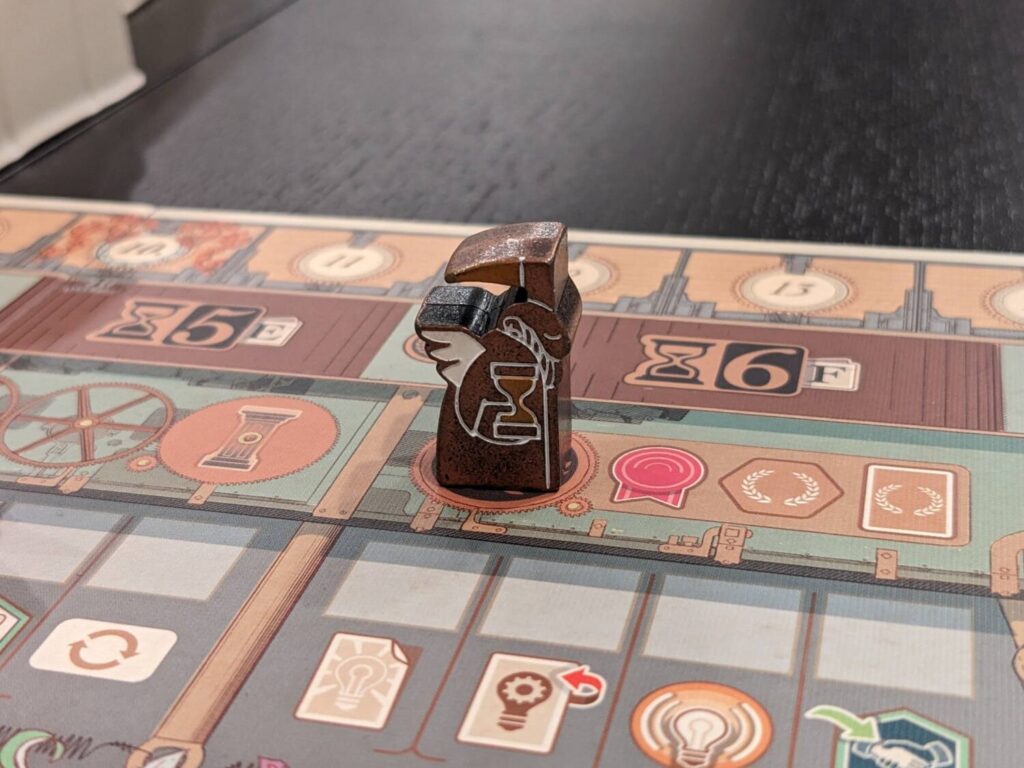
The “Player Aid”
Talk about a curveball.
Each player is given a Player Aid during setup. It’s called a Player Aid. Usually, that means this document will give players everything they need to navigate play. The reality is that the Player Aid for Inventions is mostly a reference guide for the 21 different types of Progress tiles (across the three main flavors, economy, culture and technology) along with the definition of what each Wealth tile and personal goal card requires to score.
The back of this Player Aid is quite helpful, running down the steps for each round, end of Era cleanup, and end-game scoring. Great. The best thing about the Player Aid is the list of Tips on the inside back cover. Like other Lacerda games, Inventions knows players are going to be asking the same 6-7 questions out loud all the time, like “I need more citizens. How do I get more?” and “Where the heck can I boost my Influence?”
As a person tasked with teaching heavy games all the time, I love the Tips section of the Player Aid. When questions come in, I point people to the Tips area and go back to what I was doing.
My issue with the Player Aids isn’t that they are not helpful; in fact, as a reference guide, the aids are very helpful and laid out exceptionally well.
BUT IT DOESN’T TELL ME HOW TURNS WORK!!!
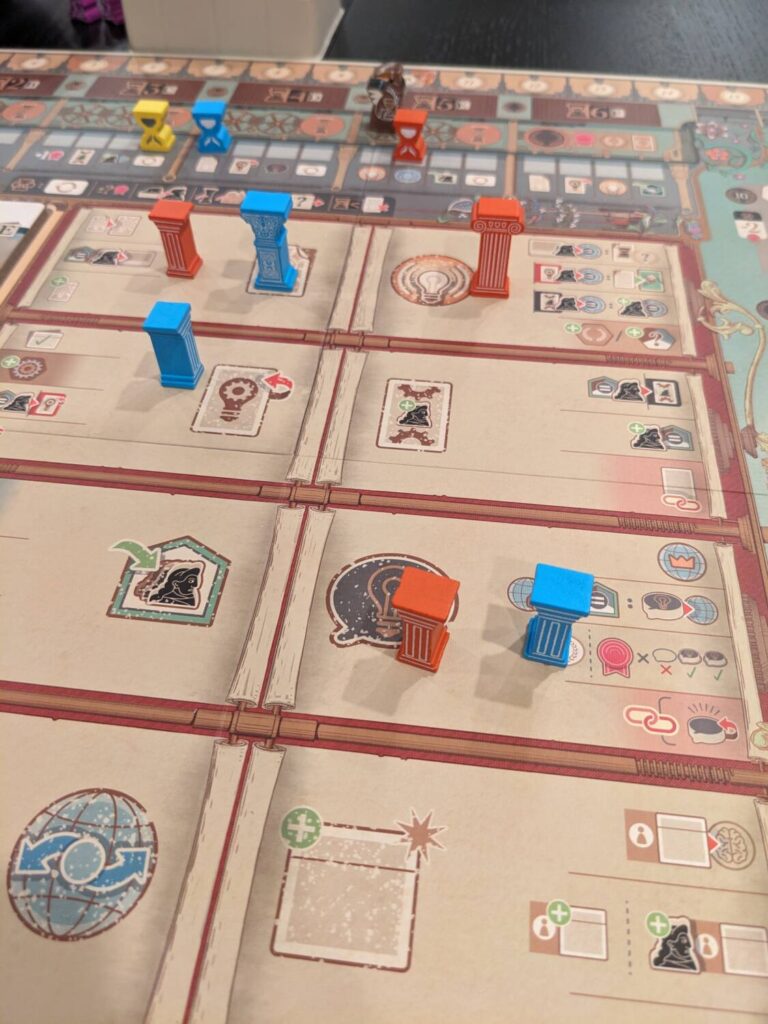
For that, you need to reference a second item, the Action Aid cards. These oversized tiles are an excellent overview of the ten actions in the game. You’ll use them a lot, because each action has a few steps. The icons for each step can also be found on the board in each action space, but, unfortunately, these icons aren’t as intuitive as I was hoping for, leaving me to reference the Action Aid more than the board.
The Action Aid is great, but it should have been included in the Player Aid. That way, all players can reference all materials all the time. That’s because there’s one major problem with the Action Aid: there’s only two of them.
Yep, Inventions is basically a three or four-player game, but each group I showed the game was shocked to find that there are only two of these Action Aids. (Well, not my wife, who did the two-player play with me. In that case, we were both very happy to not be forced to share…marriage is hard.)
It’s rare to say this, but I think Eagle-Gryphon whiffed by not including four Action Aids. The game is hard, there’s a ton of rules, and I need four Action Aids. Period!
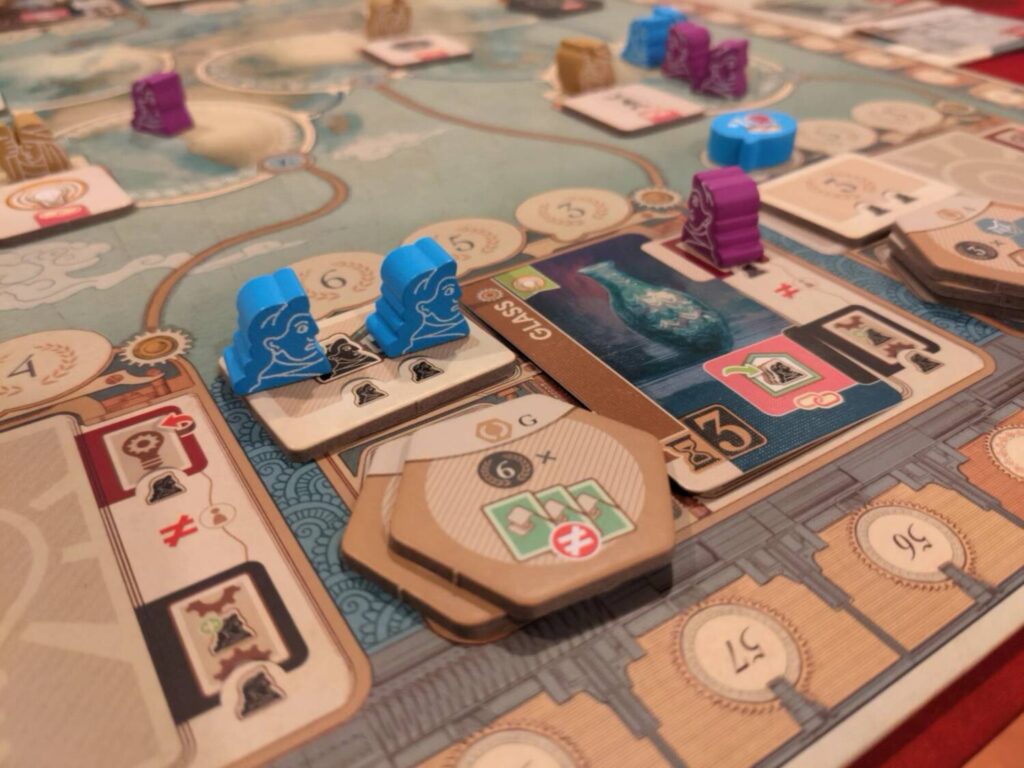
What Else Didn’t Work?
All my complaints about Inventions are pretty minor, mainly in the realm of quality-of-life issues.
Icons. I’ll start here by saying that I, like most sensible tabletop fans, believe Ian O’Toole to be without peer. His work on Voidfall is the gold standard for successfully translating crazy-difficult gameplay into intuitive iconography. Still, legends make mistakes, and a few icons in Inventions offend more than others, such as the Send Diplomat and Call Diplomat icons.
The Send Diplomat icon should be the Call Diplomat icon—the handshake symbol, with an arrow pointing towards the icon. I’m sending a Diplomat to a location, so the arrow should be pointing at it. The Call Diplomat icon should feature an arrow pointing away from the handshake icon. In English, this probably should have a different name altogether, such as Recall Diplomat, but here we are.
Other icons that miss the mark: the Politics culture tile, the icon that indicates how many Progress tiles you can build on a turn, and the Call Specialists action, which suffers the same fate as the Call Diplomat icon…it just makes more sense to point the arrow away from an icon to indicate that this means you remove meeples from an area.
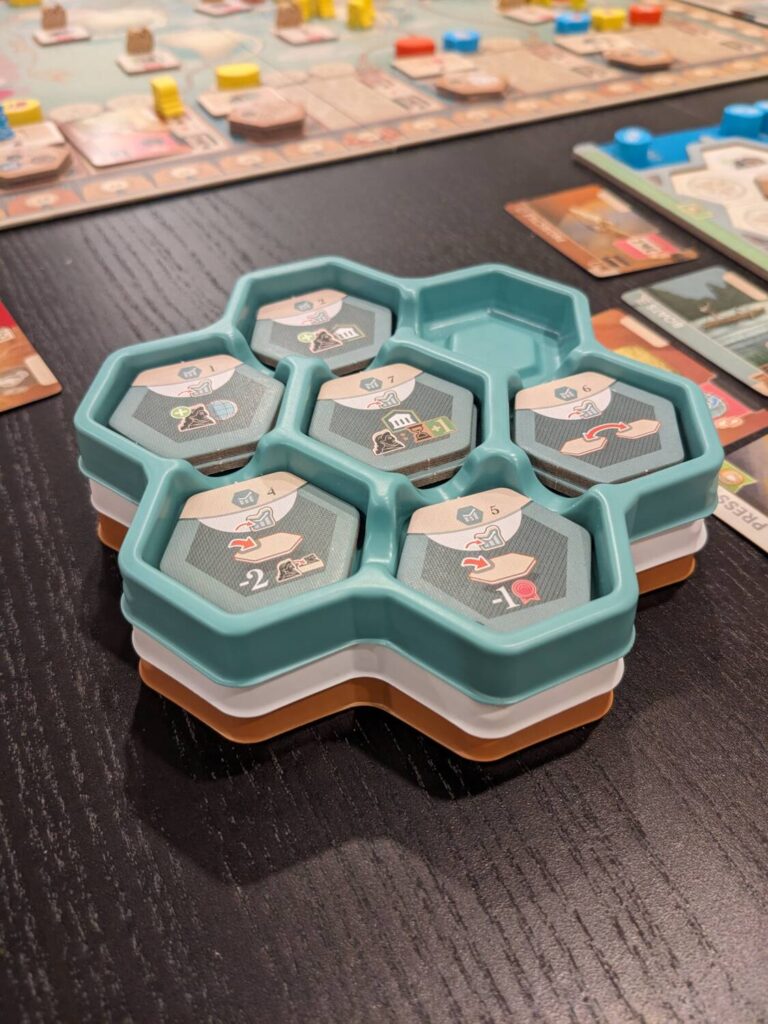
Turn order. Here’s how little turn order matters in Inventions: the game doesn’t even come with a first player marker. That isn’t only because turn order is tracked on the board, or that some of the other Lacerda games also lack a first player marker.
I think turn order is irrelevant here simply because almost nothing a player does blocks any other player. I don’t think of Inventions as a race, like I did with games like Kanban EV, where turn order is more about turn timing than the order. In Inventions, I never felt like I was hurt by going third in player order during three-player games. I never felt like someone got the jump on me by placing one of their smaller Pillars of Time (known as Seasons token) on a space, because those don’t reward the owner with any bonuses.
No one EVER took the “change turn order” bonus in my plays of Inventions by moving ahead to the next Era during Eureka actions except for the bot/automa, which automatically takes the right-most space in the Era it moves into. (Players will always opt for an extra action, in a game about taking a bunch of extra actions.)
Much like Lacerda’s most recent heavy design, Weather Machine, I think turn order is a mirage in Inventions. I’m really surprised that it was even provided as a variable. Maybe, just maybe, I would move ahead in turn order to ensure I get my hands on one of the limited Wealth tiles that can be added to a player’s Progress Map before someone else grabs the one I want. But those are relatively easy to get. I’m not passing up an extra action for a tile.
The map. This one is very minor: I wish that the lines connecting regions of the world to their “Region Display” nearby were thicker and easier to read from a distance. As is, I’ve already seen a player make the mistake of thinking their map circle was tied to a region display below that was tied to a different section. This minor issue extends to the fact that regions 4 and 6 “wrap” to connect as a travel route, but that is not immediately clear when looking at how to move around.
Also, the numbers for the seven regions of the map don’t go in the order you are thinking they should. This is explained with a historical note from Lacerda in the instruction manual, but from a quality of life perspective, I would vote to just number the regions from left to right.

Well Played, Sir
Inventions is fantastic. The game has grown on me with each play, and even during the first play for many of those who tried the game with me, there was a lot to like as the game’s layers slowly revealed themselves.
Hardcore Lacerda fans bought Inventions during the crowdfunding campaign, so we’ll assume that if you are here, you are searching for (and finding) evidence of your confirmation bias. For everyone else, though…should gamers pick this one up?
I think Inventions is worth a look if you can embrace a rules overhead that equates to Lacerda’s heaviest design. It’s shocking to say that the same man who built On Mars, Kanban EV and Weather Machine has made a harder, heavier game with Inventions, but here we are.

For you, the game’s owner, you are looking at a 45-minute teach for your first game and keeping the rulebook open for the entire first play. Inventions is a classic “re-teach” game to me. During my second game (and first with my heavy strategy group), I was still teaching rules until the 13th and final turn of the game.
I’m a little worried that Lacerda is trying to outdo himself with every game by making them harder to grasp, not easier to learn. The accessibility on-ramp is under construction with Inventions; I’m still shocked that my wife stuck with me during this massive teach, but I think many people will feel Inventions has too many rules for the sake of making the layers harder to see.
But if the games continue to be as good as Inventions—note that I was not a fan of Weather Machine, which really did feel like it had rules purely for the sake of it—count me in for upcoming games like Speakeasy and everything else Lacerda has up his sleeves in the future.
Find a group that loves games with both tactical and strategic elements that is willing to invest in multiple plays, and I think Inventions will be very rewarding for the creative, inventive gamers in your life.



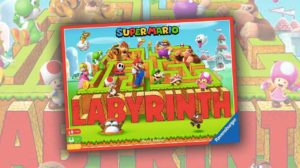







Add Comment